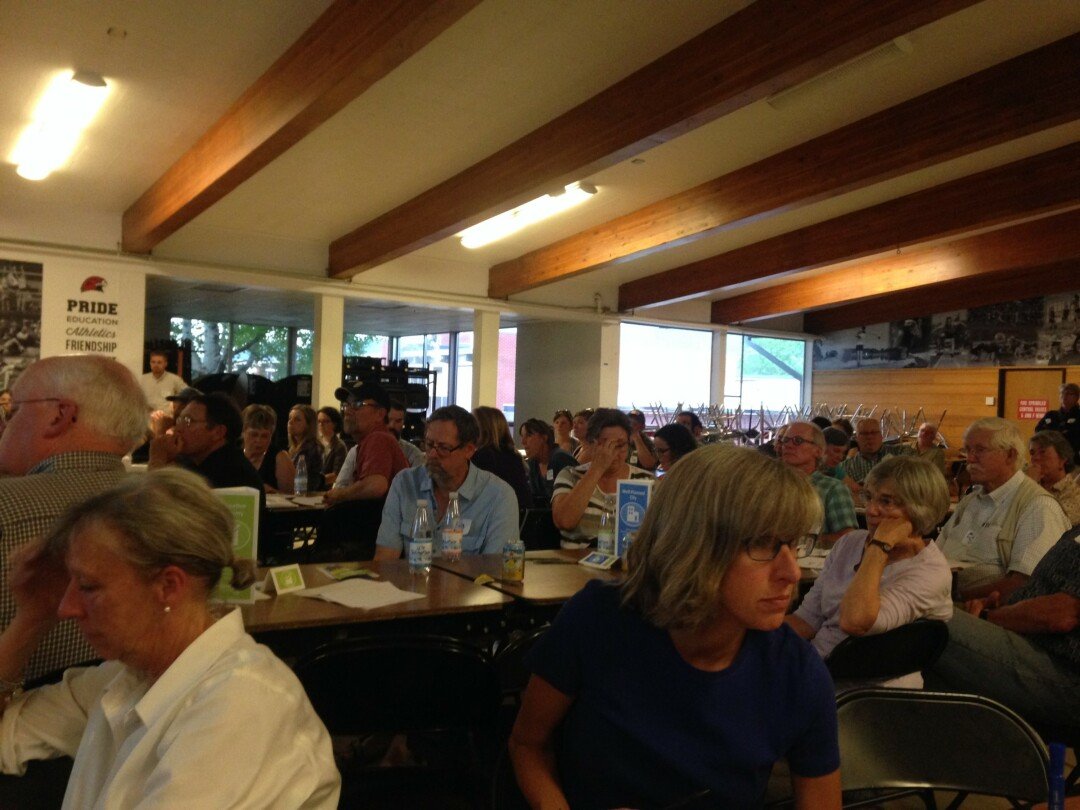A Vision of Bozeman’s Future
Kris Drummond | Friday Jul. 1st, 2016
A bead of sweat dropped from my eyelid as I looked over to the wall of Bozeman High School’s South cafeteria and saw the painting that my graduating class, the class of 2007, signed as we prepared to embark on our lives. I was shocked. Nine years ago when I signed the painting with a careless sharpie stroke, I never imagined I’d be back in that cafeteria, let alone back to participate in Bozeman’s “Strategic Plan Community Workshop.” Back then, I wasn’t concerned with much besides skiing and things I couldn’t tell my parents. So the opportunity to reflect upon my first decade as an adult was revelatory. I care about stuff now. Values and all that. A sense of social responsibility has even begun to creep in. As people shuffled around the room on a muggy Thursday evening in early June, I was pulled into a reminiscence of what life was like back in 2007, and more to the theme of the evening, what Bozeman was like. And again, I was shocked. The image I had of my town back then was very different from one I have now. It feels like a completely different place. Others agreed. Genial conversation carried an edge of concern and an undertone of hope that maybe we’d be heard by the people who make decisions. And so it was clear from the very start that this meeting was about more than simply plotting a course into the future. It was about figuring out what Bozeman was and is, and what it’s becoming as we float into the murky waters of the 21st century. Like a temperamental teenager looking ahead to the rest of her life, like the confused, hopeful person signing a painting in that cafeteria nine years ago, I realized this meeting was, in a way, focused on growing up.
The Strategic Plan Community Workshop was hosted by the city to address Bozeman’s rapid growth and all the challenges that come with the process of expansion. Upon arrival, we were instructed to choose one of six categories, and move to a table to sit with others interested in that topic. The topics were Safe, Healthy People; Innovative Economy; Sustainable Development; Engaged Community; Well-planned City; and Education, Creativity, and Culture. I was there as a writer, so “Education, Creativity, and Culture” seemed the most relevant. I picked up the yellow card signifying my alliance and joined five others. We smiled and greeted each other, and while we waited for the last few people to trickle in, I picked up a packet titled “60 trends in forecasting the future of Bozeman” and flipped to the first page, “Top Ten Global Trends in 2015.” Reading through the list, a familiar gnawing grew in my belly. 1. Deepening Income Inequality 2. Persistent Jobless Growth 3. Lack of Leadership...5. Weakening Levels of Representative Democracy...7. Increasing Occurrence of Severe Weather Events...and on it went. It was a sobering beginning that put the meeting in perspective. Not only is Bozeman in the midst of a defining moment, but the world as a whole is at a critical juncture. It’s easy to forget that amidst our still-peaceful paradise, a great shift is taking place. Turning my phone off, I took a deep breath and prepared to give my full attention.
The meeting started with the usual stuff. Smiles and “thanks for coming out” and “help yourself to refreshments.” And when everyone had a soda, we jumped into the discussion. Four questions stared up at us from the worksheet: What do you most appreciate about Bozeman? What is the biggest challenge for Bozeman now or in the future? What is your vision for the future of Bozeman? What is one strategy for achieving your vision? The next two hours were spent discussing the questions from the perspective of our respective focus areas, distilling ideas to a succinct bullet point or three, and then sharing with the whole meeting via microphone. Strong points were made and as things progressed, clear themes emerged. Most agreed that what makes Bozeman great is access to the outdoors, the wide array of cultural and educational opportunities, strong public schools, a sense of place and community...the list went on. As anyone who has lived here for even a short time knows, tooting our own horn is the easy part. Bozeman is incredible. And if that’s all it was, there would be no need for a strategy meeting. But when we got to the second question, things got interesting.
As we embarked on a discussion of the challenges facing our town-turned-city, the energy in the room shifted. Voices dropped. Seriousness ensued. Watching the room, I saw sweeping gestures as half-finished letters to the editor poured forth. People nodded as others voiced their concerns. One man in my group, who’s name I forgot, pointed to each of us accusatorially after some discussion.
“Okay, so how long have each of you lived in Bozeman? I’ve been here since ‘72 and I remember when...”
The litany is familiar, even cliche. Some version of “Bozeman used to be...” And I’ve used those words myself. Bozeman used to be many things, all of them different than what exists now. But change happens. The internet has opened access to greater possibilities and this, combined with growing disillusionment in the American dream, has people searching for a more fulfilling life. And Bozeman seems to be a popular landing pad for those with enough guts to rewrite the script of their lives. The problem, at least for many in attendance, was how to keep Bozeman a great place to live while rapid growth collides with an array of global issues that aren’t going away.
Various concerns were raised at the meeting--many aspects of the challenges we face, but there was a uniting theme: Growth as a symptom of money interests. The real question of the evening seemed to be how does Bozeman stay Bozeman as dollars pour in, dollars that too often speak louder than integrity? As the microphone passed from group to group, there was talk of stopping sprawl, focusing on sustainability, keeping a larger community engaged, limiting corporate access. Someone in my group made a snide comment about “Panda Express and others like it” and I smiled in agreement. At a table in the back, a man stood up, grabbed the microphone, and gave what felt like a sermon.
“...Instead of allowing developers to plan the city and adding infrastructure afterwards, we have to plan the infrastructure first, and develop the city to our vision, not theirs.”
For the first time, the room clapped. The effect that corporate culture has had on Bozeman in recent years is obvious. More asphalt, more strip malls, more traffic, more glowing neon signs. It made me wonder what the point of expansion is if Bozeman becomes the place that people move here to get away from. And it felt nice to be in the company of others who wondered the same. Above all the rest, the need to reclaim the power of Bozeman’s future away from developers and money interests seemed to be the uniting force of the night.
As things wrapped up, people fidgeted as sweat and smells got distracting. I felt a satisfied exhaustion. Attending the meeting wasn’t fun, exactly. But it wasn’t work either. Really, it was an interesting opportunity to participate in the ground-level growing pains of a city filled with caring, intelligent people. It was a welcome relief; a recognition that many Bozemanites share a beautiful vision of what the city can be, even as the population rises and the dynamics of local life inevitably shift. One of the organizers, Cassie Davis, held the microphone at the front of the room for the closing remarks and while thanking us for showing up, she also stressed the importance of continued engagement. Specifically, she called on us to speak to the younger generations for help with the process. And scanning the room, I realized that the “youth,” my own age group, was the main demographic conspicuously absent from the high school cafeteria. And for full disclosure, had I not been assigned to write about the event, I wouldn’t have been there either. Meetings are just something us millenials “don’t do.” But if that’s the case, if we keep insisting on a stance of cool apathy, we’ll have to accept the results when the people who do “do meetings” implement their policies.
When we are kids, we learn the lesson that at some point, we have to grow up. Nobody is ever told to dig their heels in and insist that squeezing a tube of toothpaste into the sink is acceptable adult behavior. We’re taught that we will mature and change, and that if we work with the process, we’ll be successful. If we’re lucky, we are supported in facing ever-increasing challenges that push us to expand. And the same holds true with cultural shifts on both a local and global scale. While a hundred-something people sat in the South cafeteria of Bozeman High School discussing how to work with population increase and big money interests, people in cities around the country were doing the same. Bozeman’s not actually that special. It’s a microcosm of what’s happening everywhere, and the only way to address any of the massive issues of the contemporary world is to look to our own doorstep with passion and creativity. Attempting to lock down and “keep things the way they are” will only lead to frustration and potentially, the apocalypse. Over the next few months, we’re lucky enough to have a forum to be heard, to meet other engaged people, and to grow into a responsible community that acknowledges the reality of the city and the world we’re actually living in.
The Bozeman Strategic Plan session was the first of what will be a series of workshops that aim to draft a vision of Bozeman’s future. As far as I can tell from the website schedule (bozeman.net/strategicplan) there will be two more yet-to-be-scheduled meetings to draft a vision and a strategy for implementing it. The whole process will be wrapped up by October. So let’s do the thing, whatever that means, and take part in the shaping of our great citytown.
| Tweet |



